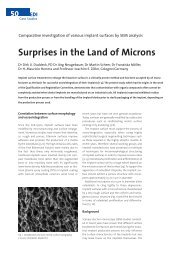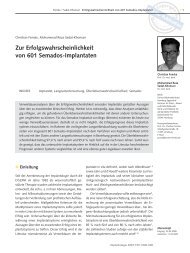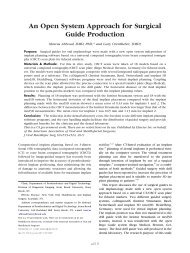implantaten und Aufbau - BEGO
implantaten und Aufbau - BEGO
implantaten und Aufbau - BEGO
Sie wollen auch ein ePaper? Erhöhen Sie die Reichweite Ihrer Titel.
YUMPU macht aus Druck-PDFs automatisch weboptimierte ePaper, die Google liebt.
ZWRDas deutsche<br />
Zahnärzteblatt<br />
www.thieme.de/zwr 10 · 2008<br />
Sonderdruck<br />
▶ In-vitro-Korrosionsstrommessung<br />
zwischen Titan<strong>implantaten</strong><br />
<strong>und</strong> <strong>Aufbau</strong>ten<br />
aus Titan,Gold- <strong>und</strong><br />
Kobaltchrom-Legierungen<br />
In-vitro corrosion current measurement<br />
between titanium implants and superstructures<br />
made of titanium, gold and<br />
cobalt chrome alloys
GO FOR GOLD.<br />
Semados ®<br />
Mini-Implantat<br />
mit Einbringpfosten<br />
Semados ®<br />
RI-Implantat mit Wirobond ®<br />
MI-Pfosten<br />
Semados ®<br />
S-Implantat mit<br />
Keramikpfosten<br />
BIONIK-DESIGN –<br />
NATÜRLICHE PERFEKTION.<br />
Die <strong>BEGO</strong><br />
Implantat Familie<br />
für alle Indikationen!<br />
Semados ® Mini-Line (durchmesserreduziert)<br />
Semados ® RI-Line (wurzelförmig)<br />
Semados ® S-Line (gerade)<br />
<strong>BEGO</strong> Semados ® Implantate verkörpern:<br />
Indikationsoptimiertes Konturdesign<br />
Spannungsoptimierte Implantat-Abutmentverbindung<br />
Hochreine Oberfläche TiPure Plus<br />
Reizfreie Schleimhautanlagerung<br />
100 % deutsches Design <strong>und</strong> Fertigung<br />
<strong>BEGO</strong> Semados ® Implantate = Stressreduktion im Implantat <strong>und</strong><br />
im Knochen für langanhaltenden Erfolg.<br />
Mini-/ OsseoPlus-Tray,<br />
Systemunabhängiges Instrumentarium<br />
für Bone Spreading <strong>und</strong><br />
Condensing<br />
www.bego-implantology.com<br />
www.adwork.de
Originalia –– Materials Werkstoffk<strong>und</strong>e Science<br />
3<br />
In-vitro-Korrosionsstrommessung zwischen<br />
Titan<strong>implantaten</strong> <strong>und</strong> <strong>Aufbau</strong>ten aus<br />
Titan,Gold- <strong>und</strong> Kobaltchrom-Legierungen<br />
M. Gente, J. Dati, P. Günter, S. Pruß, S. Rickmeyer, S. Vittur<br />
Marburg<br />
Bei Verlust eines Zahns kann die entstehende<br />
Lücke durch eine Brücke geschlossen werden.<br />
Weisen die benachbarten Zähne keine oder<br />
kleine Hartsubstanzdefekte auf, so ist beim Brückenaufbau<br />
eine Schädigung der benachbarten<br />
Zähne unvermeidbar. Das Setzen eines Implantates<br />
ist hier die günstigere Lösung. Weiter können<br />
Implantate isoliert für Zahnersatz herangezogen<br />
werden. Deshalb finden Implantate trotz<br />
der hohen Kosten eine wachsende Anwendung.<br />
Beim Einsatz des Implantatwerkstoffes muss jedoch<br />
die Auswirkung auf andere im M<strong>und</strong> befindliche<br />
Metalle hinsichtlich der Korrosion beachtet<br />
werden. Dabei versteht man unter Korrosion<br />
die allmähliche Zerstörung eines Werkstoffes<br />
unter Einwirkung anderer Stoffe aus seiner<br />
Umgebung. Das Implantat <strong>und</strong> die jeweiligen<br />
<strong>Aufbau</strong>ten aus Metall bilden ein galvanisches<br />
Element. Ziel der vorgestellten Arbeit ist es, die<br />
Korrosionsströme zwischen einem Titan-Implantat<br />
<strong>und</strong> verschiedenen metallischen <strong>Aufbau</strong>materialien<br />
zu untersuchen.<br />
Material <strong>und</strong> Methode<br />
Es sollten die Korrosionsströme zwischen Implantat<br />
(Semados S 3,75 L13, LOT 902621, Bego<br />
Implantat-Systems Bremen) <strong>und</strong> den <strong>Aufbau</strong>ten<br />
aus einer gegossenen, hochgoldhaltigen Legierung<br />
(Degunorm, Degussa Hanau), vorgefertigten<br />
<strong>Aufbau</strong>ten aus Reintitan (Sub-Tec Titanpfosten<br />
S 5,5, LOT 901728, Bego Implantat-Systems<br />
Bremen) <strong>und</strong> vorgefertigten CoCrMo-<strong>Aufbau</strong>ten<br />
(Sub-Tec Wirobond ® MI Pfosten 5,5, LOT<br />
902286, Bego Implantat-Systems Bremen) untersucht<br />
werden. Die Zusammensetzungen der<br />
Legierungen sind in Tab. 1 entsprechend der<br />
Herstellerangaben genannt.<br />
Da die Oberfläche der zylindrischen <strong>Aufbau</strong>ten<br />
nicht mit Schleifpapier gleichmäßig bearbeitet<br />
werden konnte, wurden, um eine einheitliche<br />
Oberfläche der <strong>Aufbau</strong>materialien zu gewährleisten,<br />
alle <strong>Aufbau</strong>ten mit Strahlmittel der<br />
Es wurden Korrosionsströme des Kontaktelements Titan-Implantat gepaart<br />
mit <strong>Aufbau</strong>ten aus verschiedenen Dentalmetallen (CoCrMo-Legierung<br />
Wirobond, Titan des Reinheitsgrades 4 <strong>und</strong> der hochgoldhaltigen Legierung<br />
Degunorm) untersucht. Als Elektrolyte wurden sowohl ungepufferte,<br />
physiologische Kochsalzlösung mit einem pH-Wert von 6 als auch mit einem<br />
pH-Wert von 2,3, der durch Milchsäurezusatz eingestellt wurde, verwendet.<br />
Das Kontaktelement Titan-Implantat/Kobaltchrom-<strong>Aufbau</strong> weist in beiden<br />
Lösungen die geringste Korrosionsstromdichte von ca. 3 nA/cm² auf. Die Korrosionsstromdichte,<br />
die für <strong>Aufbau</strong>ten aus Titan bzw. einer hochgoldhaltigen<br />
Legierung gemessen wurden, lagen mit bis zu 100 nA/cm² bzw. 180 nA/cm²<br />
deutlich höher. Die Ergebnisse dieser Untersuchung lassen den Einsatz von<br />
CoCrMo-<strong>Aufbau</strong>ten auf Implantaten aus Sicht ihrer Korrosionsbeständigkeit<br />
mindestens so unbedenklich erscheinen wie die Verwendung von Titan oder<br />
hochgoldhaltiger Edelmetalllegierungen.<br />
Körnung 110 µm (Korox, <strong>BEGO</strong> Bremen) bei<br />
2 bar Druck gestrahlt, bis eine matte Oberfläche<br />
entstand. Die <strong>Aufbau</strong>ten wurden anschießend<br />
7 Tage trocken an der Luft gelagert, sodass<br />
sich Passivierungsschichten wieder ausbilden<br />
konnten.<br />
Die für die Spannungsmessung erforderlichen<br />
Drähte wurden am Implantat <strong>und</strong> am <strong>Aufbau</strong> angebracht.<br />
Damit das Kupfer der Drähte nicht in<br />
Lösung ging, wurden die Verbindungsstellen<br />
sorgfältig mit lichthärtendem Komposit (Grandio<br />
Tab. 1<br />
Zusammensetzungen der Legierungen<br />
Schlüsselwörter<br />
Korrosion – Implantate –<br />
Dentallegierungen<br />
Gold Titan CoCr<br />
Degunorm Massen % Reintitan Massen % Wirobond Massen %<br />
Grad 4<br />
Gold 73,8 Titan 99,8 Cobalt 61,5<br />
Platin 9,0 Rest 0,2 Chrom 26,0<br />
Silber 9,2 (Sauerstoff, Molybdän 6,0<br />
Kupfer 4,4 Kohlenstoff, Wolfram 5,0<br />
Zink 2,0 Wasserstoff) Rest 1,5<br />
Rest<br />
(Iridium,<br />
Indium)<br />
1,6 (Eisen,<br />
Silizium)<br />
ZWR ̶ Das Deutsche Zahnärzteblatt 2008; 117 (10)
4 Originalia – Werkstoffk<strong>und</strong>e<br />
Tab. 2<br />
Metall-Paarung<br />
Implantat mit<br />
Tab. 3 Beträge der Kurzschlussstromdichten in nA/cm 2<br />
Metall-Paarung<br />
Implantat mit<br />
NaCl-Lösung in beiden<br />
Halbelementen [nA/cm 2 ]<br />
kleinster<br />
Wert<br />
größter<br />
Wert<br />
Mittelwert<br />
NaCl-Lösung <strong>und</strong><br />
Milchsäurelösung [nA/cm 2 ]<br />
kleinster<br />
Wert<br />
größter<br />
Wert<br />
Mittelwert<br />
Gold-<br />
7 128 57,8 24 472 177,2<br />
Legierung<br />
Titan-<strong>Aufbau</strong> 44 160 61,1 10 216 102,4<br />
CoCrMo-Legierung<br />
Potenzialunterschiede der verschiedenen Kombinationen<br />
Implantat/<strong>Aufbau</strong> in mV<br />
NaCl-Lösung in beiden Halbelementen<br />
Implantat in NaCl-Lösung <strong>und</strong><br />
<strong>Aufbau</strong> in Milchsäurelösung<br />
+ <strong>Aufbau</strong> bildet die Kathode/ – <strong>Aufbau</strong> bildet die Anode<br />
[mV]<br />
kleinster<br />
Wert<br />
größter<br />
Wert<br />
Mittelwert<br />
kleinster<br />
Wert<br />
größter<br />
Wert<br />
1,9 6,1 3,1 3,6 5,4 2,9<br />
Mittelwert<br />
Gold-Legierung –230 +95 –81 –290 +139 –30<br />
Titan-<strong>Aufbau</strong> –290 +180 –18 –460 –38 –219<br />
CoCrMo-<br />
Legierung<br />
+106 +129 +120 –75 +113 +37<br />
Flow A1, VOCO, Cuxhaven) abgedeckt. Die Abb. 1<br />
zeigt ein Implantat <strong>und</strong> Abb. 2 einen CoCr-<strong>Aufbau</strong><br />
mit der abgedichteten Verbindungsstelle.<br />
Zur Untersuchung wurden 2 Reagenzgläser nach<br />
Abb. 3 aufgebaut. Die Reagenzgläser wurden<br />
mithilfe von Parafilm luftdicht verschlossen, um<br />
ein Verdunsten zu verhindern. Eine Salzbrücke<br />
verbindet die beiden Gefäße, den Mindestquerschnitt<br />
von ca. 0,5 mm² sichert ein in dem Brückenschlauch<br />
befindlicher Woll faden.<br />
Das Implantat befindet sich in physiologischer<br />
NaCl-Lösung mit einem pH-Wert von 6,0. Die<br />
NaCl-Lösung soll das Milieu im Knochen- bzw.<br />
Hautgewebe imitieren. Für die <strong>Aufbau</strong>ten fanden<br />
2 verschiedene Lösungen Verwendung: zunächst<br />
ebenfalls physiologische NaCl-Lösung,<br />
zum anderen dieselbe Lösung mit einem Zusatz<br />
von Milchsäure, wodurch der pH-Wert von 6,0<br />
auf 2,3 gesenkt wurde. Dadurch wird die Situation<br />
nachgeahmt, bei der in der Plaque durch<br />
anaeroben Abbau von Zuckern der pH-Wert absinkt.<br />
In einem galvanischen Element lösen sich aus<br />
der Anode Metallionen, bei einer elektrisch leitenden<br />
Verbindung zur Kathode entsteht ein<br />
elektrischer Strom. Der fließende Strom in der<br />
galvanischen Zelle stellt ein Maß für die Korrosion<br />
dar. Da eine größere Oberfläche einen stärkeren<br />
Elektronenfluss möglich macht als eine<br />
kleinere, ist es sinnvoll den Strom auf die Oberfläche<br />
zu beziehen. Die maximale Korrosionsgeschwindigkeit<br />
tritt bei maximalem Stromfluss,<br />
d.h. bei Kurzschluss, auf. Deshalb wird<br />
der Stromfluss, verursacht durch das Spannungspotenzial<br />
des galvanischen Elements, bei<br />
verschiedenen Verbraucherwiderständen gemessen.<br />
Abb. 4 zeigt das Ersatzschaltbild der<br />
Versuchsanordnung mit dem inneren Widerstand<br />
R i<br />
, dem Lastwiderstand R L<br />
<strong>und</strong> dem Voltmeter.<br />
Zunächst wurde die Spannung nach Entfernen<br />
von R L<br />
nach 24 h gemessen, sodass nur noch der<br />
Innenwiderstand des Voltmeters (Röhrenvoltmeter<br />
der Genauigkeitsklasse 0,5% mit 1 Volt<br />
Schreiberausgang der Firma Colora Messtechnik<br />
GmbH, Berlin, R i<br />
> 100 GΩ) gegeben war.<br />
Dann folgten nach weiteren 24 h unter der Last<br />
3 MΩ <strong>und</strong> abschließend ebenfalls nach 24 h unter<br />
der Last 1 MΩ (Metallfilmwiderstände der<br />
Genauigkeitsklasse 1%, Belastbarkeit 0,125 Watt)<br />
weitere Messungen. Innerhalb dieser Zeiten<br />
stellten sich stabile Spannungswerte ein, die<br />
mit einem xt-Schreiber (Siemens Kompensograph<br />
X-T C1011) dokumentiert wurden.<br />
Korrosionsstrommessungen können nach Heitz<br />
et al. (1990) als Spannungsmessungen an ohmschen<br />
Widerständen durchgeführt werden [2].<br />
Mit dieser Methode kann man Kurzschlussströme<br />
in galvanischen Elementen jedoch nicht<br />
bestimmen, da dafür die Spannung an einem<br />
Widerstandswert von 0 Ω gemessen werden<br />
müsste, was natürlich unmöglich ist. Deswegen<br />
wurde durch lineare Extrapolation der Spannung-Strom-Kennlinie<br />
für eine Spannung von<br />
0 Volt (Kurzschluss) der „Kurzschlussstrom“<br />
berechnet. Diese Methode setzt zwar einen<br />
ohmschen Innenwiderstand des galvanischen<br />
Elements voraus (Abb. 4), stellt aber für kleinere<br />
Abweichungen der Stromquelle vom ohmschen<br />
Gesetz immer noch eine gute Näherung<br />
dar. Eine Alternative wäre die Verwendung eines<br />
Potentiostaten, mit dem der Innenwiderstand<br />
des Strommessers elektronisch kompensiert<br />
werden kann.<br />
Bei Messungen mit dem <strong>Aufbau</strong> in der NaCl-<br />
Milchsäurelösung wurde der pH-Wert im Gefäß<br />
des Implantates durch Diffusion über die<br />
Salzbrücke beeinflusst, er lag nach der Messung<br />
zwischen 4 <strong>und</strong> 3,5. Für den pH-Wert der<br />
Milchsäurelösung wurde keine Änderung nachgewiesen.<br />
Als Beispiel ist die Auswertung der Messungen<br />
bei der Paarung Implantat/CoCr-Legierung in<br />
Abb. 5 dargestellt. Für jedes der 3 <strong>Aufbau</strong>materialen<br />
wurden 4 Paare vermessen.<br />
Ergebnisse <strong>und</strong> Diskussion<br />
Die Potenzialunterschiede für das unbelastete<br />
galvanische Element sind in Tab. 2 dargestellt.<br />
Bei positivem Vorzeichen bildete das Implantat<br />
die Anode, bei negativem Vorzeichen der <strong>Aufbau</strong>.<br />
ZWR ̶ Das Deutsche Zahnärzteblatt 2008; 117 (10)
Originalia – Werkstoffk<strong>und</strong>e<br />
5<br />
Die Korrosion <strong>und</strong> auch eine mögliche biologische<br />
Wirkung eines galvanischen Elements<br />
hängen von der Menge der pro Zeiteinheit in<br />
Lösung gehenden Metallionen ab. Diese wird<br />
nicht vom Potenzialunterschied, sondern durch<br />
den Kurzschlussstrom bestimmt, sodass im<br />
Folgenden die berechneten Kurzschlussstromdichten<br />
anhand der in Tab. 3 dargestellten<br />
Werte diskutiert werden.<br />
Die geringste Stromdichte wurde sowohl bei<br />
der Salzlösung als auch bei der Korrosionslösung<br />
zwischen dem Titan-Implantat <strong>und</strong> dem<br />
CoCr-<strong>Aufbau</strong> festgestellt. Offensichtlich hat der<br />
pH-Wert auf die Korrosion der CoCr-Legierung<br />
im Gegensatz zu den anderen <strong>Aufbau</strong>materialien<br />
keinen nennenswerten Einfluss. Kulmburg<br />
(2006) berichtet, dass Korrosionsströme der<br />
Paarung Reintitan-CoCrMoNb um den Faktor<br />
10 bis 100 kleiner ausfallen als die Paarung<br />
Reintitan/hochgoldhaltige Legierung, was mit<br />
den Ergebnissen unserer Messungen gut übereinstimmt<br />
[4].<br />
Der unerwartete Potenzialunterschied <strong>und</strong> der<br />
Stromfluss zwischen dem Titan-Implantat <strong>und</strong><br />
dem Titan-<strong>Aufbau</strong> lassen sich vermutlich auf<br />
Unterschiede im Metallgefüge zurückführen.<br />
So sind sowohl die Oberfläche des <strong>Aufbau</strong>s als<br />
auch die des Implantates gestrahlt <strong>und</strong> damit<br />
nicht mehr homogen, da das Strahlen eine gewisse<br />
Druckspannung in der Metalloberfläche<br />
erzeugt [3]. Mechanische Spannungen können<br />
prinzipiell das Korrosionsverhalten von Metallen<br />
verändern, in der Regel weisen die verformten<br />
Gebiete eine höhere Korrosionsanfälligkeit<br />
auf [1]. Für Inhomogenitäten spricht auch, dass<br />
die Titan-<strong>Aufbau</strong>ten sowohl edler als auch unedler<br />
als die Implantatoberflächen in der NaCl-<br />
Lösung bei einem pH-Wert von 6,0 reagiert haben.<br />
Erst bei einem niedrigeren pH-Wert nach<br />
Milchsäurezusatz reagierten die Titan-<strong>Aufbau</strong>ten<br />
einheitlich unedler. Das Material des Co-<br />
CrMo-<strong>Aufbau</strong>s ist weitaus härter als das des<br />
Titan-<strong>Aufbau</strong>s. Messungen mit einem Vickers-<br />
Härteprüfgerät (CV-400DAT, CV-Instruments,<br />
Maastricht, Niederlande) ergaben unter 500 g<br />
Last Werte von 420 +/– 10 HV bzw. 320 +/– 10 HV.<br />
Es könnte sein, dass der CoCrMo-<strong>Aufbau</strong> wegen<br />
seiner höheren Härte beim Strahlen weniger in<br />
seiner Oberfläche verändert worden ist als die<br />
weichere Titan-Oberfläche <strong>und</strong> so die Streuung<br />
der Messwerte für diesen Legierungstyp kleiner<br />
ist.<br />
Bezüglich der Korrosionsströme ist in unserer<br />
Untersuchung die Paarung Titanimplantat mit<br />
dem CoCrMo-<strong>Aufbau</strong> die günstigste Kombination.<br />
Die gestrahlte Oberfläche der CoCrMo-Legierung<br />
hat ebenso wie in der Untersuchung<br />
von Kulmburg an einer CoCrMoNb-Legierung<br />
edler reagiert als die Titan-Oberfläche des Implantats.<br />
Nur für den Fall des niedrigeren pH-<br />
Abb. 1 Implantat mit abgedichteter<br />
Verbindungsstelle.<br />
Abb. 3 Die Halbelemente wurden mittels<br />
einer Salzbrücke zu einem galvanischen Element<br />
verb<strong>und</strong>en. Als Salzbrücke diente ein Kunststoffschlauch,<br />
der mit einem Wollfaden durchzogen<br />
war. (Der Schlauch wurde in der Mitte durch eine<br />
Fadenschlinge verengt, um den Ionenaustausch zu<br />
verlangsamen. Die Schlauchverbindung war mit<br />
der NaCl-Lösung <strong>und</strong> bei der Untersuchung der<br />
<strong>Aufbau</strong>ten in Korrosionslösung hälftig mit NaCl-<br />
Lösung <strong>und</strong> Korrosionslösung gefüllt.)<br />
Wertes in der NaCl-Milchsäurelösung reagierte<br />
der <strong>Aufbau</strong> in einem von 4 Versuchen unedler.<br />
Insgesamt gesehen sind alle von uns gef<strong>und</strong>enen<br />
Stromdichten deutlich kleiner als die<br />
von Kulmburg (1986) mitgeteilten Werte für<br />
die Paarungen Gold-Legierung/CoCr-Legierung<br />
<strong>und</strong> Gold-Legierung/NiCr-Legierung, für die er<br />
Werte in Höhe von 100 bis 1000 nA/cm² gef<strong>und</strong>en<br />
hat [5]. Sie sind auch kleiner als die von<br />
Taher <strong>und</strong> Al Jabab (2003) ermittelten Werte in<br />
Höhe von 10 bis 30 nA/cm² für die Paarung Titan/CoCr-Gusslegierung,<br />
was möglicherweise<br />
darauf zurückzuführen ist, dass wir es nicht<br />
mit einer vergossenen CoCr-Legierung, sondern<br />
laut Herstellerangabe mit einer homogenen industriell<br />
vorgefertigten Legierung zu tun hatten<br />
[6]. Weitgehende Übereinstimmung besteht<br />
mit den Werten von Venugopalan et al. (1998),<br />
die für die Paarung Titan/CoCrMo Ströme von<br />
1–3 nA/cm² <strong>und</strong> für Titan/Hochgold-Legierung<br />
66–154 nA/cm² angegeben haben [7].<br />
Überraschen mag, dass die vergossene Gold-<br />
Legierung unedler reagierte als die Oberfläche<br />
Abb. 2 CoCr-Implantataufbau mit<br />
abgedichteter Verbindungsstelle.<br />
Abb. 4 Ersatzschaltbild für<br />
das untersuchte galvanische<br />
Element Implantat/<strong>Aufbau</strong><br />
im verwendeten Versuchsbaufbau.<br />
U o<br />
<strong>und</strong> R i<br />
bilden<br />
das Element nach, R L<br />
ist der<br />
Lastwiderstand. Mit dem extrem<br />
hochohmigen (R>100<br />
GΩ) Voltmeter V wird die<br />
Spannung an R L<br />
gemessen.<br />
ZWR ̶ Das Deutsche Zahnärzteblatt 2008; 117 (10)
6 Originalia – Werkstoffk<strong>und</strong>e<br />
Abb. 5 Ergebnis der Messungen an 4 Paaren<br />
Implantat/CoCr-Legierung in physiologischer<br />
Kochsalzlösung. Die Kurzschlussströme wurden<br />
für abnehmende Spannungen bei steigenden<br />
Strömen gegen die Spannung 0 extrapoliert.<br />
Die freie Oberfläche des <strong>Aufbau</strong>s betrug<br />
2,2 cm².<br />
des Titan-Implantats. Laut Kulmburg (2006)<br />
wäre eine edlere Reaktion zu erwarten gewesen<br />
[4]. Reintitan habe ein sehr unedles Potenzial,<br />
das durch Passivierung um etwa 2400 mV<br />
angehoben werde <strong>und</strong> damit nicht ganz die<br />
Werte von Edelmetalllegierungen erreiche.<br />
Entscheidend für das Potenzial der Implantatoberfläche<br />
ist also die Ausprägung der Passivierungschicht.<br />
Nach Angabe des Implantatherstellers<br />
ist die Implantatoberfläche mit einem<br />
speziellen Sandstrahlverfahren hergestellt worden.<br />
Offensichtlich reagiert im vorliegenden<br />
Fall die passivierte Titan-Oberfläche edler als<br />
die gestrahlte Edelmetalloberfläche.<br />
Da das Strahlen zu einer Oberflächenvergrößerung<br />
unserer Proben geführt hat, darf man annehmen,<br />
dass alle Korrosionsströme bei glatten<br />
Oberflächen geringer ausfallen würden [1]. Daraus<br />
folgt, dass durch die von uns gewählte<br />
Form der Oberflächenbearbeitung eine besonders<br />
ungünstige Situation simuliert wurde <strong>und</strong><br />
die klinisch zu erwartenden Stromdichten kleiner<br />
sind.<br />
Klinische Relevanz<br />
Bei der Anwendung von Implantaten ist zu berücksichtigen,<br />
dass CoCr-<strong>Aufbau</strong>ten in Verbindung<br />
mit dem Titan-Implantat kleinere Korrosionsströme<br />
zeigen als <strong>Aufbau</strong>ten aus Titan oder<br />
einer hochgoldhaltigen Legierung. Während für<br />
die CoCr-Legierung kein Anstieg des Korrosionsstroms<br />
für saure pH-Werte gef<strong>und</strong>en wurde, haben<br />
sich diese für Titanaufbauten verdoppelt<br />
<strong>und</strong> für die Edelmetalllegierung verdreifacht.<br />
Die Ergebnisse dieser Untersuchung lassen den<br />
Einsatz von vorgefertigten CoCr-<strong>Aufbau</strong>ten auf<br />
Implantaten aus Sicht ihrer Korrosionsbeständigkeit<br />
mindestens so unbedenklich erscheinen<br />
wie die Verwendung von Titan oder hochgoldhaltigen<br />
Edelmetalllegierungen.<br />
Danksagung<br />
Wir bedanken uns bei der Firma Bego Implantat-Systems<br />
in Bremen für Unterstützung durch<br />
Überlassung der Implantate <strong>und</strong> der vorgefertigten<br />
Implantataufbauten.<br />
Literatur<br />
1 Borchers. Metallk<strong>und</strong>e II, Berlin: Walter de<br />
Gryter&Co. 1969<br />
2 Heitz et al. Korrosionsk<strong>und</strong>e im Experiment. Weinheim:<br />
VCH, 1990<br />
3 Hesse (Hrsg). Giesserei Lexikon. Fachverlag Schiele<br />
& Schoen, 2000<br />
4 Kulmburg et al. Untersuchung der Korrosionsbeständigkeit<br />
von Rein-Titan. Stomatologie 2006;<br />
103: 71–76<br />
5 Kulmburg et al. Die Korrosion von Nichtedelmetall<br />
(NE)-Legierungen. ZWR 1986; 95: 544–550<br />
6 Taher, Al Jabab. Galvanic corrosion behaviour of<br />
implant suprastructure dental alloys. Dental Mat<br />
2003; 19: 54–59<br />
7 Venugopalan et al. Evaluation of restaurative and<br />
implant alloys ganvanically coupled to titatnium.<br />
Dent Mat 1998; 14; 165–172<br />
Peer-reviewed paper<br />
Korrespondenzadresse<br />
Prof. Michael Gente<br />
Abt. für Zahnersatzk<strong>und</strong>e, Bereich für Propädeutik<br />
<strong>und</strong> Kiefer-Gesichts-Prothetik<br />
Medizinisches Zentrum für ZMK-Heilk<strong>und</strong>e<br />
Georg-Voigt-Str. 3, 35033 Marburg/Lahn<br />
E-Mail: michael@gente.de<br />
ZWR ̶ Das Deutsche Zahnärzteblatt 2008; 117 (10)
Originalia – Materials Science<br />
7<br />
In-vitro corrosion current measurement between<br />
titanium implants and superstructures made<br />
of titanium, gold and cobalt chrome alloys<br />
M. Gente, J. Dati, P. Günter, S. Pruss, S. Rickmeyer, S. Vittur<br />
Marburg<br />
When a tooth is lost, the resulting gap can be<br />
closed with a bridge. Although the adjoining<br />
teeth may have no hard tissue defects, or only<br />
minor defects, they will inevitably be damaged<br />
during construction of the bridge. Placement of<br />
an implant is therefore the more favourable solution.<br />
Furthermore, implants can be used in<br />
isolation for tooth replacement, which is why<br />
they are becoming increasingly popular in spite<br />
of their high cost. Nevertheless, account must<br />
be taken of the effect that the implant material<br />
will have on other metals in the mouth as regards<br />
corrosion. In this context, corrosion means<br />
the gradual degradation of a material due<br />
to the influence of other materials in its surro<strong>und</strong>ings.<br />
The implant and the respective metal<br />
superstructures form a galvanic cell. The<br />
aim of this paper is to investigate the corrosion<br />
currents between a titanium implant and various<br />
metallic superstructure materials.<br />
Materials and method<br />
The aim was to investigate the corrosion currents<br />
between an implant (Semados S 3.75 L13<br />
LOT 902621, Bego Implant Systems, Bremen)<br />
and the superstructures made of a cast, highgold<br />
alloy (Degunorm, Degussa Hanau), prefabricated<br />
superstructures made of commercially<br />
pure titanium (Sub-Tec titanium abutment S<br />
5.5, LOT 901728, Bego Implant Systems, Bremen)<br />
and prefabricated CoCrMo superstructures<br />
(Sub-Tec Wirobond ® MI abutment 5.5, LOT<br />
902286, Bego Implant Systems, Bremen). The<br />
compositions of the alloys, as stated by the manufacturers,<br />
are given in Table 1.<br />
As it was not possible to prepare the surface of<br />
the cylindrical superstructures evenly using<br />
abrasive paper, a uniform finish was ensured by<br />
sandblasting all the superstructures with an<br />
abrasive of grit size 110 µm (Korox, <strong>BEGO</strong>, Bremen),<br />
at a pressure of 2 bar, until a matt surface<br />
was produced. The superstructures were then<br />
Corrosion currents were investigated between titanium implants and superstructures<br />
made of various dental metals (CoCrMo alloy Wirobond, grade 4<br />
purity titanium and high-gold alloy Degunorm) when in electrical contact.<br />
The electrolytes used were unbuffered normal saline solution with a pH of 6<br />
and also with a pH of 2.3, created by the addition of lactic acid. The pairing<br />
of titanium implant and cobalt-chrome superstructure displayed the lowest<br />
corrosion current density, at approx. 3 nA/cm 2 in both solutions. The corrosion<br />
current density measured with superstructures made of titanium or<br />
high-gold alloy was significantly higher, at up to 100 nA/cm 2 and 180 nA/cm 2<br />
respectively. The results of this investigation indicate that CoCrMo superstructures<br />
can be used on implants at least as safely as titanium or high-gold<br />
precious-metal alloys.<br />
stored in dry air for 7 days so that passivation<br />
layers could form again.<br />
The wires required for voltage measurement<br />
were attached to the implant and the superstructure.<br />
To prevent the copper of the wires<br />
from going into solution, the connection points<br />
were carefully covered with light-curing composite<br />
(Grandio Flow A1, VOCO, Cuxhaven). Fig.<br />
1 shows an implant and Fig. 2 shows a CoCr superstructure<br />
with the sealed connection point.<br />
For the investigation, two test-tubes were set<br />
up as shown in Fig. 3. The test-tubes were<br />
sealed airtight using Parafilm to prevent evaporation.<br />
A salt bridge connects the two vessels; a<br />
Table 1<br />
Composition of the alloys<br />
Key Words<br />
Dental Corrosion – Implants<br />
– Dental Alloys<br />
Gold Titanium CoCr<br />
Degunorm % by Pure titanium<br />
% by Wirobond<br />
weight<br />
grade 4<br />
weight<br />
% by<br />
weight<br />
Gold 73,8 Titanium 99,8 Cobalt 61,5<br />
Platinium 9,0 Others 0,2 Chromium 26,0<br />
Silver 9,2 (oxygen, Molybdenum 6,0<br />
Copper 4,4 carbon, Tungsten 5,0<br />
Zinc 2,0 hydrogen) Others 1,5<br />
Others (iridium,<br />
indium)<br />
1,6 (iron, silicon)<br />
ZWR ̶ Das Deutsche Zahnärzteblatt 2008; 117 (10)
8 Originalia – Materials Science<br />
Table 3 Short-circuit current densities in nA/cm 2<br />
Metal pair<br />
Implant with<br />
Table 2 Potential differences of the various implant/superstructure<br />
combinations in mV<br />
Metal-pair NaCl solution in both half-cells Implant in NaCl solution and<br />
superstructure in lactic acid<br />
solution<br />
+ Superstructure forms the cathode/– Superstructure forms the anode<br />
[mV]<br />
Implant with<br />
lowest<br />
value<br />
NaCl solution in both half-cells<br />
[nA/cm 2 ]<br />
lowest<br />
value<br />
highest<br />
value<br />
highest<br />
value<br />
mean<br />
mean<br />
lowest<br />
value<br />
NaCl solution and lactic acid<br />
solution [nA/cm 2 ]<br />
lowest<br />
value<br />
highest<br />
value<br />
highest<br />
value<br />
mean<br />
Gold alloy –230 +95 –81 –290 +139 –30<br />
Titanium superstructure<br />
–290 +180 –18 –460 –38 –219<br />
CoCrMo alloy +106 +129 +120 –75 +113 +37<br />
mean<br />
Gold alloy 7 128 57,8 24 472 177,2<br />
Titanium superstructure<br />
44 160 61,1 10 216 102,4<br />
CoCrMo alloy 1,9 6,1 3,1 3,6 5,4 2,9<br />
wool thread in the bridge tube ensures that the<br />
minimum cross-section of approx. 0.5 mm 2 is<br />
maintained.<br />
The implant was placed in normal NaCl solution<br />
with a pH of 6.0. The NaCl solution is intended<br />
to imitate the environment in the bone/<br />
skin tissue. Two different solutions were used<br />
for the superstructures: firstly, normal NaCl solution<br />
and, secondly, the same solution with<br />
the addition of lactic acid, which reduced the<br />
pH from 6.0 to 2.3. This simulates the oral situation<br />
in which the pH is lowered in the plaque<br />
by anaerobic degradation of sugars.<br />
In a galvanic cell, metal ions dissolve out of<br />
the anode, and if there is an electrically conductive<br />
connection with the cathode, an electric<br />
current is created. The current flowing in<br />
the galvanic cell represents a measure of the<br />
corrosion. As a large surface permits a stronger<br />
electron flow than a small surface, a correlation<br />
can be made between current and<br />
surface area. The maximum rate of corrosion<br />
occurs at maximum current flow, i.e., a short<br />
circuit. For this reason, the flow of current,<br />
caused by the voltage potential of the galvanic<br />
cell, is measured with various load resistances.<br />
Fig. 4 shows the equivalent circuit<br />
diagram of the test setup with the internal<br />
resistance Ri, the load resistance RL and the<br />
voltmeter.<br />
First, the voltage was measured after 24 hours,<br />
after removing RL so that only the internal resistance<br />
of the voltmeter (vacuum tube voltmeter<br />
of accuracy class 0.5% with 1 volt recorder<br />
output, from Colora Messtechnik GmbH,<br />
Berlin, Ri > 100 GΩ) applied. Then, after a<br />
further 24 hours, further measurements were<br />
taken <strong>und</strong>er a load of 3 MΩ and finally, again<br />
after 24 hours, <strong>und</strong>er a load of 1 MΩ (metallicfilm<br />
resistors of accuracy class 1%, load rating<br />
0.125 watts). Within these periods of time, the<br />
voltage values stabilised and were documented<br />
with an xt recorder (Siemens potentiometric<br />
recorder X-T C1011).<br />
Corrosion current measurements can be carried<br />
out as voltage measurements at ohmic resistances,<br />
as described by Heitz et al. (1990) [2].<br />
However, with this method, short-circuit currents<br />
in galvanic cells cannot be determined,<br />
because that would require the voltage to be<br />
measured at a resistance of 0 Ω, which is of<br />
course impossible. Therefore the “short-circuit<br />
current” was calculated by linear extrapolation<br />
of the voltage-current characteristic for a voltage<br />
of 0 volts (short circuit). Although this method<br />
assumes an ohmic internal resistance of<br />
the galvanic cell (Fig. 4), it still delivers a good<br />
approximation for relatively small deviations of<br />
the current source from Ohm’s law. An alternative<br />
would be to use a potentiostat, with which<br />
the internal resistance of the ammeter can be<br />
electronically compensated.<br />
For measurements with the superstructure in<br />
the NaCl/lactic acid solution, the pH in the implant<br />
test-tube was influenced by diffusion via<br />
the salt bridge. According to the measurement,<br />
it was between 4 and 3.5. No change was detected<br />
in the pH of the lactic acid solution,<br />
As an example, Fig. 5 shows the evaluation of<br />
measurements with the implant/CoCr alloy<br />
pair. Four pairs were measured for each of the<br />
three superstructure materials.<br />
Results and discussion<br />
The potential differences for the unloaded galvanic<br />
cell are shown in Table 2. Positive figures<br />
mean that the implant formed the anode, while<br />
negative figures indicate that the superstructure<br />
formed the anode.<br />
The corrosion and also a possible biological effect<br />
of a galvanic cell depend on the quantity of<br />
metal ions which go into solution per unit of<br />
time. This is determined not by the potential<br />
difference, but by the short-circuit current, so<br />
the calculated short-circuit currents are discussed<br />
below on the basis of the figures in Table<br />
3.<br />
The lowest current density was measured between<br />
the titanium implant and the CoCr superstructure,<br />
in both the saline solution and the<br />
corrosion solution. Evidently, the pH has no appreciable<br />
influence on the corrosion of the CoCr<br />
ZWR ̶ Das Deutsche Zahnärzteblatt 2008; 117 (10)
Originalia – Materials Science<br />
9<br />
Fig. 1 Implant with sealed connection<br />
point<br />
Load resistance<br />
Wool thread<br />
Salt bridge<br />
Superstructure<br />
Implant<br />
Electrolyte<br />
Fig. 3 The half-cells were joined by a salt<br />
bridge to form a galvanic cell. A plastic tube<br />
with a wool thread passing through it served as<br />
the salt bridge. (The tube was constricted in the<br />
middle by a thread loop in order to slow down<br />
the ion exchange. The connecting tube was<br />
filled with the NaCl solution, and when examining<br />
the superstructures in corrosion solution,<br />
the tube was filled half-and-half with NaCl solution<br />
and corrosion solution.)<br />
alloy, in contrast to the other superstructure<br />
materials. Kulmburg (2006) reports that corrosion<br />
currents with the commercially pure titanium/CoCrMoNb<br />
pairing are smaller than with<br />
the commercially pure titanium/high-gold alloy<br />
pairing by a factor of 10 to 100. This is consistent<br />
with the results of our measurements<br />
[4].<br />
The unexpected potential difference and the<br />
flow of current between titanium implant and<br />
titanium superstructure are presumably attributable<br />
to differences in the microstructure of<br />
the metal. The surface of both the superstructure<br />
and the implant were sandblasted and<br />
therefore were no longer homogeneous because<br />
the blasting generates a certain compressive<br />
stress in the metal surface [3]. Mechanical<br />
stresses can, in principle, change the corrosion<br />
behaviour of metals. As a rule, the areas that<br />
have been deformed display increased susceptibility<br />
to corrosion [1]. A further indication of<br />
inhomogeneities is the fact that the titanium<br />
superstructures reacted both more nobly and<br />
less nobly than the implant surfaces in the NaCl<br />
solution at a pH of 6.0. Only at a lower pH, following<br />
the addition of lactic acid, did the titanium<br />
superstructures react consistently less<br />
nobly. The material of the CoCrMo superstructure<br />
is far harder than that of the titanium superstructure.<br />
Measurements with a Vickers<br />
hardness testing device (CV-400DAT, CV-Instruments,<br />
Maastricht, Netherlands) produced<br />
values of 420 +/– 10 HV and 320 +/– 10 HV <strong>und</strong>er<br />
a load of 500 g. It could be that the surface<br />
of the CoCrMo superstructure was changed less<br />
by the sandblasting due to its greater hardness<br />
compared to the softer titanium surface, and<br />
therefore the spread of measurements is smaller<br />
for this alloy.<br />
In terms of the corrosion currents, our investigation<br />
showed the titanium implant/CoCrMo<br />
superstructure pair to be the most favourable<br />
combination. The sandblasted surface of the<br />
CoCrMo alloy reacted more nobly than the titanium<br />
surface, as was the case in Kulmburg’s<br />
investigation using a CoCrMoNb alloy. Only in<br />
the case of the lower pH in the NaCl/lactic acid<br />
solution did the superstructure react less nobly<br />
in one out of four tests. Overall, all the current<br />
densities that we measured were considerably<br />
lower than those reported by Kulmburg (1986)<br />
for the gold alloy/CoCr alloy and gold alloy/NiCr<br />
alloy pairings, for which he obtained values of<br />
100 to 1000 nA/cm 2 [5]. They are also lower<br />
than the values recorded by Taher and Al Jabab<br />
(2003), which were 10 to 30 nA/cm 2 for the titanium/CoCr<br />
cast alloy pairing. This may be attributable<br />
to the fact that we did not use a cast<br />
CoCr alloy, but, according to the manufacturer,<br />
a homogeneous, industrially prefabricated alloy<br />
[6]. There is a good overall match with the<br />
findings of Venugopalan et al. (1998), who reported<br />
currents of 1–3 nA/cm 2 for the titanium/<br />
CoCrMo pairing and 66–154 nA/cm 2 for titanium/high-gold<br />
alloy [7].<br />
It may seem surprising that the cast gold alloy<br />
reacted less nobly than the surface of the titanium<br />
implant. According to Kulmburg (2006), a<br />
more noble reaction would be expected [4]. He<br />
states that commercially pure titanium has a<br />
very base potential, which can be raised by<br />
aro<strong>und</strong> 2400 mV by means of passivation, so<br />
falling just short of the values of precious-metal<br />
alloys. The decisive factor influencing the potential<br />
of the implant surface is thus the development<br />
of the passivation layer. According to<br />
the implant manufacturer, the implant surface<br />
was produced by a special sandblasting process.<br />
Evidently, in the case in hand, the passivated<br />
titanium surface reacts more nobly than<br />
the sandblasted precious-metal surface.<br />
As the sandblasting had the effect of increasing<br />
the surface area of our samples, it may be assu-<br />
Fig. 2 CoCr implant superstructure<br />
with sealed connection point<br />
Fig. 4 Equivalent circuit<br />
diagram for the examined<br />
galvanic cell with implant/<br />
superstructure in the test<br />
set up used. Uo and Ri simulate<br />
the cell; RL is the load<br />
resistance. The voltage at RL<br />
is measured with the external<br />
high-impedance (R>100<br />
GΩ) voltmeter V.<br />
ZWR ̶ Das Deutsche Zahnärzteblatt 2008; 117 (10)
10 Originalia – Materials Science<br />
Voltage [mV]<br />
300<br />
200<br />
100<br />
0<br />
–100<br />
Implant against CoCr in NaCl<br />
Sample 1<br />
Sample 2<br />
Sample 3<br />
Sample 4<br />
Current [nA]<br />
for the CoCr alloy at acidic pH values, the corrosion<br />
currents doubled for titanium superstructures<br />
and tripled for the precious-metal alloy.<br />
The results of this investigation indicate that<br />
prefabricated CoCr superstructures can be used<br />
on implants at least as safely as titanium or<br />
high-gold precious-metal alloys.<br />
Acknowledgement<br />
We wish to thank Bego Implant Systems in Bremen<br />
for supplying the implants and the prefabricated<br />
implant superstructures.<br />
Fig. 5 Result of measurements on four implant/CoCr<br />
alloy pairs in normal saline solution.<br />
The short-circuit currents were extrapolated for<br />
decreasing voltages with increasing currents<br />
against a voltage of 0 V. The free surface area of<br />
the superstructure was 2.2 cm 2 .<br />
med that all the corrosion currents would be<br />
smaller on smooth surfaces [1]. It therefore follows<br />
that the form of surface treatment selected<br />
by us simulated a particularly unfavourable<br />
situation and the current densities to be expected<br />
in the clinical situation are smaller.<br />
Clinical relevance<br />
When using implants, it must be remembered<br />
that CoCr superstructures in combination with<br />
titanium implants display smaller corrosion<br />
currents than is the case with superstructures<br />
made of titanium or a high-gold alloy. Whereas<br />
no increase in the corrosion current was fo<strong>und</strong><br />
Literatur<br />
1 Borchers. Metallk<strong>und</strong>e II, Berlin: Walter de<br />
Gryter&Co. 1969<br />
2 Heitz et al. Korrosionsk<strong>und</strong>e im Experiment. Weinheim:<br />
VCH, 1990<br />
3 Hesse (Hrsg). Giesserei Lexikon. Fachverlag Schiele<br />
& Schoen, 2000<br />
4 Kulmburg et al. Untersuchung der Korrosionsbeständigkeit<br />
von Rein-Titan. Stomatologie 2006;<br />
103: 71–76<br />
5 Kulmburg et al. Die Korrosion von Nichtedelmetall<br />
(NE)-Legierungen. ZWR 1986; 95: 544–550<br />
6 Taher, Al Jabab. Galvanic corrosion behaviour of<br />
implant suprastructure dental alloys. Dental Mat<br />
2003; 19: 54–59<br />
7 Venugopalan et al. Evaluation of restaurative and<br />
implant alloys ganvanically coupled to titatnium.<br />
Dent Mat 1998; 14; 165–172<br />
Peer-reviewed paper<br />
Address for correspondence<br />
Prof. Michael Gente<br />
Abt. für Zahnersatzk<strong>und</strong>e, Bereich für Propädeutik<br />
<strong>und</strong> Kiefer-Gesichts-Prothetik<br />
Medizinisches Zentrum für ZMK-Heilk<strong>und</strong>e<br />
Georg-Voigt-Str. 3, 35033 Marburg/Lahn, Germany<br />
E-mail: michael@gente.de<br />
Impressum<br />
Schriftleitung <strong>und</strong> Redaktion<br />
Dr. med. dent. Cornelia Gins<br />
Platanenallee 39, 14050 Berlin<br />
Tel.: 030/3041600, Fax 030/3054574<br />
E-Mail: Dr.C.Gins@t-online.de<br />
Herstellung/Layout: Wolfgang Eckl<br />
Verlag: Georg Thieme Verlag KG<br />
Rüdigerstraße 14, 70469 Stuttgart<br />
ZWR ̶ Das Deutsche Zahnärzteblatt 2008; 117 (10)
GO FOR GOLD.<br />
GO FOR<br />
GOLD.<br />
Bionic Engineering Design zielt auf die Übertragung<br />
von Optimallösungen der Natur auf technische<br />
Produkte – hier Implantate –<br />
Semados ®<br />
Mini-Implant<br />
Semados ®<br />
RI-Implant<br />
Semados ®<br />
S-Implant<br />
USING BIONIC DESIGN<br />
TO BECOME A LEADER IN TECHNOLOGY<br />
The <strong>BEGO</strong><br />
implant NEU! family<br />
for all indications!<br />
Mini-Implantate für die<br />
Versorgung schmaler Frontzahnlücken<br />
Semados Durchmesserreduzierte ® Mini-Line (reduced Implantate diameter)<br />
Systemunabhängiges Semados ® RI-Line Instrumentarium<br />
(root shaped)<br />
für Bone Spreading <strong>und</strong> Condensing<br />
Semados ® S-Line (straight)<br />
Nehmen Sie Bezug auf diese Anzeige<br />
<strong>und</strong> freuen Mini-/ Sie OsseoPlus-Tray,<br />
sich über besonders<br />
System-independent attraktive Konditionen instrument bei Ihrer<br />
set nächsten for bone Bestellung! spreading and<br />
condensing<br />
<strong>BEGO</strong> Semados ® implants embody:<br />
indication-optimised shape design<br />
stress-optimised implant-abutment connection<br />
high-purity TiPure Plus surface<br />
100% German design – 100% German manufacturing<br />
<strong>BEGO</strong> Semados ® implants = stress reduction in the implant<br />
and the bone for long-lasting success<br />
www.bego-implantology.com<br />
ww.adwork.de www.adwork.de
WIROBOND ® 280<br />
DYNAMIC SOLUTIONS<br />
Wirobond ® 280<br />
> Extremely Resistant to Corrosion<br />
> Proven Biocompatibility<br />
> Improved Easy Finishing due to lower<br />
Vicker’s Hardness<br />
> Superbly suitable for Crown and Bridge<br />
Restorations on Implant Designs<br />
<strong>BEGO</strong> Bremer Goldschlägerei · Wilh. Herbst GmbH & Co. KG<br />
Wilhelm-Herbst-Straße 1 · 28359 Bremen<br />
Tel. +49 (0) 421 - 20 28 0 · Fax +49 (0) 421 - 20 28 100<br />
www.bego.com<br />
Order no.: 84138, Vers. 00


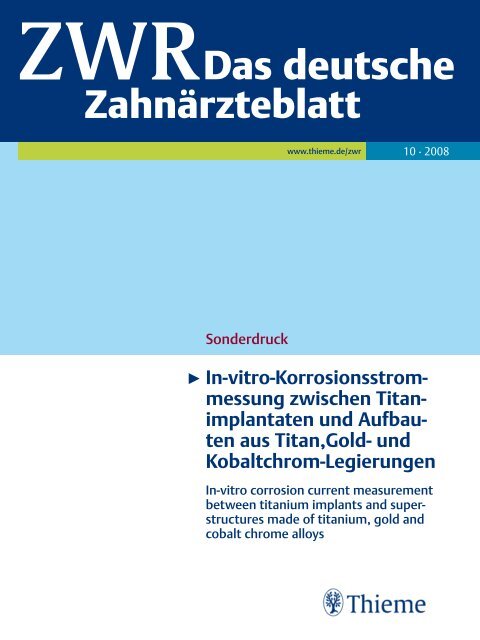
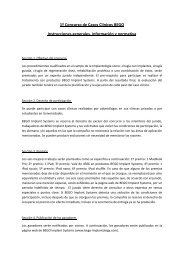
![Folleto del curso [3449823B/pdf] - BEGO](https://img.yumpu.com/49168777/1/184x260/folleto-del-curso-3449823b-pdf-bego.jpg?quality=85)
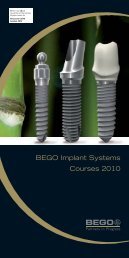
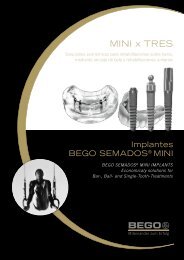
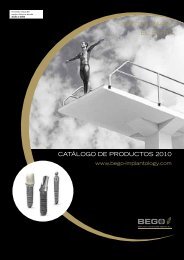
![Folleto del curso [1975602B/pdf] - BEGO](https://img.yumpu.com/35748327/1/190x190/folleto-del-curso-1975602b-pdf-bego.jpg?quality=85)
